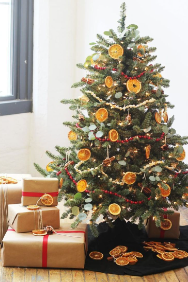Take the Holidays Out of the Dump

Kraft paper is a more sustainable option for gift wrapping.
December 19, 2022
Between Thanksgiving and the New Year, an additional one million tons of trash are created each week. This has a massive impact on the environment and could be greatly reduced if we all made a small change this holiday season. Being sustainable can be easy if you know what to do.
Supporting local tree farms is a great way to be more sustainable if you celebrate Christmas. Fake Christmas trees are typically made of PVC, one of the most toxic types of plastic. It is possible to offset the carbon footprint of having a fake tree if you use it for over ten years; however, even when you do that, the PVC will never biodegrade and will only become smaller pieces of plastic. When you buy from a local tree farm, you are not only supporting a local business, but you’re also buying a tree that can later be turned into mulch, lumber, or can be composted.
Every year, 52% of Americans surveyed admit to getting at least one unwanted gift over the holidays. That is an unimaginable amount of items either getting returned or going to landfills. To make sure you’re giving gifts your loved ones actually want, ask them. Christmas lists are not only fun to make but are also extremely helpful for the people doing the shopping. Buying or making something that’s consumable is a great way to work around the guessing game that comes with purchasing a present for someone you don’t really know. You could thrift a cookie tin and bake some festive treats. Make a handmade card with materials you have lying around your house, and then you have a super easy, budget-friendly, and sustainable holiday gift.
A well-known tradition on Christmas is unwrapping presents. The association of wrapped presents with Christmas is likely due to the biblical story where the three wise men wrapped the gifts they brought to baby Jesus. However, the first recorded form of wrapping gifts was done by people who practiced Korean folk religions from 184-190 CE. They used fabric to wrap their gifts and believed it was a symbol of protection and good luck. During the 1600s, another fabric wrapping style came about and this is called furoshiki. Wrapping gifts in fabric is incredibly sustainable. The wrapping paper we think of today often is coated in plastic and can not be recycled. A trick to figuring out if your wrapping paper is recyclable is to scrunch it into a ball; if when you let go it stays scrunched then it likely can be recycled. To avoid creating more paper waste, you can use fabric, leftover material from packages, or reused gift bags from previous holidays. The most sustainable thing you can do is to use what you have.
None of these suggestions should be encouraging you to throw away your less eco-friendly products. Sustainability is a process that takes time and lots of small changes, so enjoy the holidays and don’t be too hard on yourself for creating some waste.





